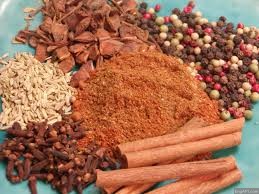

spice
音标:
英音/ spaɪs / 美音/ spaɪs /
听听基本释意:
外刊例句:
A blissed-out house record, spiced with elements of Afrobeats and Brazilian pop, it’s a euphoric hymn to the unifying power of dance music.
这是一个充满幸福的房屋唱片,加入了Afrobeats和巴西流行音乐的元素,这是舞蹈音乐统一力量的欣喜赞美诗。
—BBC
Vapes containing the drug spice or other illicit substances, food and even chewing gum could be used for spiking, according to the force.
根据该部队的说法,含有药物香料或其他非法物质,食物甚至口香糖的VAP可以用于峰值。
—BBC
Mr Pirathapan cooked a winning menu of a seafood starter, a spiced venison main and a dessert of white chocolate and cardamom and saffron cremeux with a lime and chili sorbet.
Pirathapan先生为海鲜开胃菜,五香鹿肉主菜以及白巧克力和豆蔻和藏红花克雷梅克斯的甜点烹制了一个获胜的菜单。
—BBC
基本释意:
none
none
香料,调味品;情趣,趣味;赤褐色;<北英格兰>糖果;<罕>少许
同义词:
没有找到同义词
短释义:
Spices make your food more interesting and flavorful. Something that increases the excitement in other parts of life can also be called spice, like when the rivalry between two basketball players adds spice to the game. You can spice things up when you’re telling a story by adding colorful details.
您可以用辣椒粉增添餐点 – 也可以用迪斯科球为您的房间增添味道!香料通常是食物的调味料,但是您可以通过爵士乐将香料添加香料。
长释义:
Spices make your food more interesting and flavorful. Something that increases the excitement in other parts of life can also be called spice, like when the rivalry between two basketball players adds spice to the game. You can spice things up when you’re telling a story by adding colorful details.
香料使您的食物更有趣和美味。增加生活中其他部分兴奋的东西也可以称为香料,例如,当两个篮球运动员之间的竞争增加了香料时。通过添加丰富多彩的细节来讲述故事时,您可以为事情提供香料。
文学例句:
When I raised it to my parted lips, odd spices struck my nose: chili, paprika, and cumin.
当我将其抬到分开的嘴唇上时,奇怪的香料击中了我的鼻子:辣椒,辣椒粉和小茴香。
—Sir Fig Newton and the Science of Persistence by Sonja Thomas
“I need the Quassia’s spice nectar to mix into the Elixir of Light you make.”
“我需要Quassia的香料花蜜混合到您制作的光精灵中。”
—The Marvellers by Dhonielle Clayton
All the spices blew into the air at once.
所有的香料立即吹入空中。
—The Many Assassinations of Samir, the Seller of Dreams by Daniel Nayeri
词源:
spice(n.)c. 1200, “vegetable substance aromatic or pungent to the taste added to food or drink to enhance the flavor,” also “a spice used as a medication or an alchemical ingredient,” from Anglo-French spece, Old French espice (Modern French épice), from Late Latin species (plural) “spices, goods, wares,” in classical Latin “kind, sort” (see species, which is a doublet).
From c. 1300 as “an aromatic spice,” also “spices as commodities;” from early 14c. as “a spice-bearing plant.” Of odors or perfumes by 1560s. The figurative sense of “attractive or enjoyable variation” is from 13c.; that of “slight touch or trace of something” is recorded from 1530s. The meaning “specimen, sample” is from 1790. Early druggists recognized four “types” of spices: saffron, clove, cinnamon, nutmeg.also from c. 1200
下面是词源的翻译(机器翻译比较难翻,参考着看)
香料(n。)c。 1200, “vegetable substance aromatic or pungent to the taste added to food or drink to enhance the flavor,” also “a spice used as a medication or an alchemical ingredient,” from Anglo-French spece, Old French espice (Modern French épice), from Late Latin species (plural) “spices, goods, wares,” in classical Latin “kind, sort” (see species, which is a doublet).来自c。 1300作为“芳香香料”,也是“香料作为商品”;从14c初。作为“香料植物”。到1560年代的气味或香水。 “有吸引力或令人愉悦的变化”的象征意义来自13c。从1530年代记录了“轻微的触摸或痕迹”。含义“标本,样品”是从1790年开始的。早期的药物识别出四种“香料类型”:藏红花,丁香,肉桂,肉豆蔻。 1200
本站没有存储任何书籍、杂志和报纸。
页面内容只做展示和推荐。如果您喜欢本期内容请购买正版。
This site does not store any books, magazines or newspapers.
The contents of the pages are for display and recommendation only.
If you like the content of this issue please purchase the original.